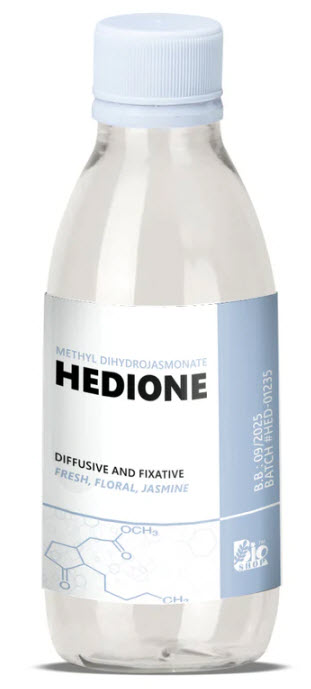Hedione (chemical name: Methyl Dihydrojasmonate) is one of the most important and widely used aroma chemicals in modern perfumery. It is celebrated for its fresh, floral, and slightly citrusy scent, which adds a transparent, airy, and radiant quality to fragrances. Below is a detailed explanation of Hedione, including its properties, uses, and significance in perfumery.

1. Chemical Structure and Properties
- Chemical Name: Methyl dihydrojasmonate
- IUPAC Name: Methyl (1R,2R)-3-oxo-2-pentylcyclopentaneacetate
- Molecular Formula: C₁₃H₂₂O₃
- Molecular Weight: 226.31 g/mol
- Appearance: A colorless to pale yellow liquid.
- Odor: Fresh, floral, jasmine-like, slightly citrusy, and green with a transparent, airy quality.
- Solubility: Insoluble in water but soluble in alcohol and oils, making it suitable for use in perfumes and cosmetic formulations.
- Boiling Point: Approximately 300°C (572°F).
- Stability: Stable under normal conditions but can degrade under strong acids, bases, or UV light.
2. Natural Occurrence
Hedione is a synthetic compound inspired by the natural molecule methyl jasmonate, which is found in jasmine absolute and other floral extracts. However, Hedione itself does not occur naturally. It was first synthesized in the 1960s by Firmenich, a leading fragrance and flavor company, and has since become a cornerstone of modern perfumery.
3. Role in Perfumery
Hedione is a versatile fragrance ingredient with several key roles:
- Floral Enhancer: It is widely used to create or enhance floral accords, particularly jasmine, gardenia, and other white floral notes.
- Blending Agent: It harmonizes well with other floral, citrus, and woody notes, creating a balanced and radiant scent profile.
- Diffusion Enhancer: It adds a transparent, airy, and expansive quality to fragrances, making them feel lighter and more diffusive.
- Fixative: It helps stabilize and prolong the scent of a perfume by slowing down the evaporation of more volatile components.
4. Fragrance Profile
Hedione contributes the following olfactory characteristics to a perfume:
- Floral: Imparts a soft, sweet, and jasmine-like floral note.
- Fresh: Adds a bright, uplifting, and slightly citrusy freshness.
- Green: Provides a subtle, leafy, and slightly herbal undertone.
- Transparent: Creates a light, airy, and radiant quality, enhancing the overall diffusion of the fragrance.
5. Common Uses in Perfumes
Hedione is a staple in many fragrance families, including:
- Floral Fragrances: It is a key component in floral perfumes, particularly those featuring jasmine, gardenia, and other white floral notes.
- Fresh Fragrances: Its fresh and airy qualities make it ideal for light and uplifting compositions.
- Citrus Fragrances: It complements the bright and zesty notes in citrus-based perfumes.
- Oriental Fragrances: It adds a soft, floral, and radiant quality to warm and spicy oriental compositions.
- Chypre Fragrances: It enhances the floral and green accords in chypre perfumes.
6. Safety and Regulation
Hedione is generally considered safe for use in cosmetics and fragrances when used within recommended concentrations. Key points include:
- IFRA Compliance: The International Fragrance Association (IFRA) sets guidelines for the maximum allowable concentration of Hedione in different product types to ensure safety.
- Allergen Potential: It is not classified as a significant allergen, but it is always recommended to conduct patch tests to ensure it does not cause adverse reactions in sensitive individuals.
7. Advantages in Perfumery
- Versatility: It blends well with a wide range of fragrance materials, including florals, citruses, and woods.
- Diffusion: Its transparent and airy qualities enhance the diffusion and radiance of a fragrance.
- Floral Realism: It effectively mimics the scent of jasmine, a flower that is expensive and difficult to extract.
- Cost-Effectiveness: As a synthetic ingredient, it is more affordable than natural jasmine absolute.
8. Limitations
- Overuse: Due to its popularity, it can be overused in some fragrances, leading to a generic or “synthetic” smell.
- Regulatory Restrictions: Compliance with IFRA and EU regulations may restrict its use in certain formulations.
9. Example Perfumes Featuring Hedione
Hedione is found in numerous iconic fragrances, including:
- Dior Eau Sauvage: Enhances the fresh and citrusy notes.
- Chanel No. 5: Complements the floral and powdery accords.
- Calvin Klein Eternity: Adds a soft, floral, and radiant quality to the composition.
10. Conclusion
Hedione is a fundamental aroma chemical in modern perfumery, prized for its fresh, floral, and transparent characteristics. Its ability to enhance floral accords, improve diffusion, and add a radiant quality makes it indispensable in creating light, airy, and elegant fragrances. While it is generally safe, its potential for overuse necessitates careful formulation and adherence to regulatory guidelines. Its versatility and unique scent profile ensure its continued prominence in the fragrance industry.